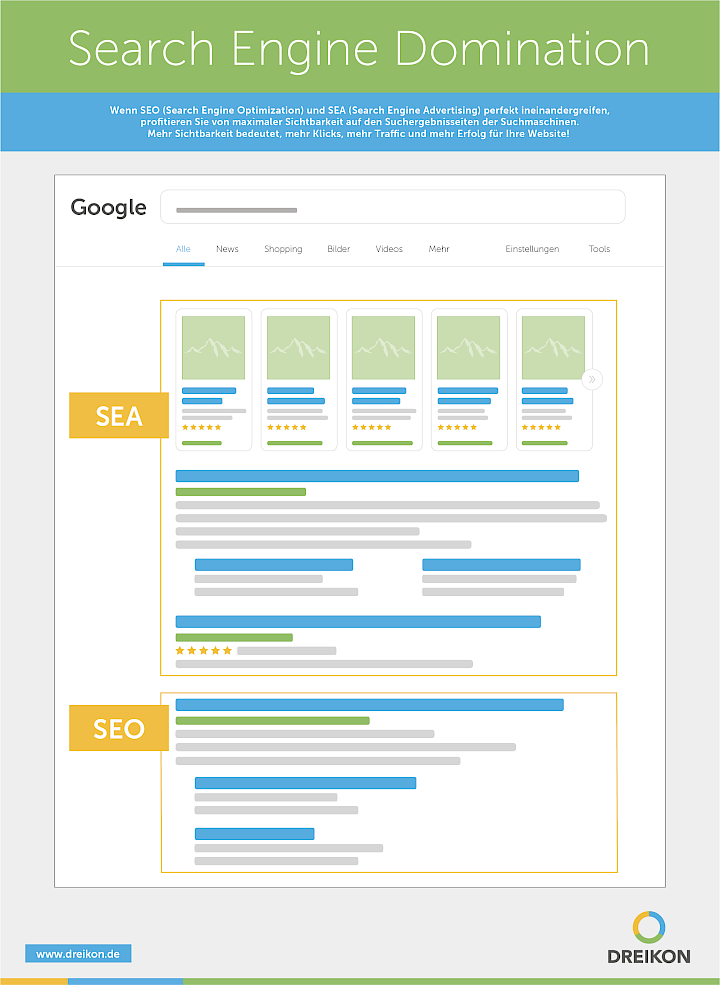Search engine advertising, also known as SEA (Search Engine Advertising), is a sub-discipline of online marketing and, together with search engine optimization (SEO), is a central component of search engine marketing. SEA involves placing advertisements, either in text or image form, on search engines such as Google or Bing. These advertisements are then displayed in prominent positions on the search results pages (SERPs). The placement of advertisements through SEA is one of the most important sources of income for these search engine providers.
The most important things at a glance:
Definition: Paid ads in search engines (e.g. Google, Bing) for quick visibility
Goal: Immediate traffic through placement above/below the organic search results
Differentiation from SEO: SEA = short-term & paid, SEO = long-term & organic
Cost model: CPC, CPA, CPM or cost per view (e.g. for YouTube)
Ad formats: Text ads, shopping ads, display banners, video ads
Platforms: Google Ads, Microsoft Advertising (Bing Ads)
Control: Bid auction + quality factor determine ad position
Area of application: Fast visibility, sales, lead generation & remarketing campaigns
What is SEA and what is the difference to SEO?
While search engine optimization is about improving organic search results, SEA is based on paid measures. SEA is seen as a short-term strategy, as the campaigns are controlled by bidding on specific and relevant keywords, the costs of which can vary depending on the intensity of competition and the search term. The ads placed therefore lead to an immediate increase in website traffic.
SEA therefore ensures fast results through paid ads. SEO, on the other hand, aims to improve the visibility of a website in organic search engine rankings in the long term. This approach focuses on optimizing the website to make it more relevant for the search engine algorithm. The positioning in the search results is determined directly by the search engine algorithm, based on how well the content of the website matches the search queries. SEA, on the other hand, offers the opportunity to directly influence the placement of ads through financial means and thus control visibility in the short term.

How does SEA work?
The placement of ads in search engines is based on the selection and booking of specific keywords that determine the search queries for which an ad is delivered and presented to the user. Costs only arise for the advertiser when a user clicks on the ad and is redirected to the associated landing page, for example a specific product page in the online store. This means that the ad itself does not incur any direct costs. The costs per click (cost per click, CPC for short) vary and are influenced by
- The competition for the selected keyword
- The ad position
- The quality of the Google Ads account, measured by the quality factor
As competition for a keyword increases, the cost per click also tends to rise. When the ad is delivered, the search engine carries out an auction for each query in which the CPC and quality score of an advertiser's ad are compared with those of competing ads. The maximum CPC and quality score of each ad are multiplied to determine its rank in the auction. The ad with the highest total score is given the top position, followed by the ads with the next highest values.
SEA - not just advertising on search engines
SEA in its classic form refers to text ads that are placed on search engines such as Google and Bing. Advertising on YouTube also falls under this category and can therefore be considered a component of SEA. When it comes to Google Ads, however, the term refers to a much broader range of advertising formats. SEA with Google Ads not only includes ads in Google's search results, but also extends to display advertising, i.e. banners placed on other websites, ads on YouTube, advertising content in the email inboxes of Gmail users and product ads in Google Shopping. The boundaries to SEA are becoming increasingly blurred, as Google Ads offers a variety of advertising options that go beyond traditional text search advertising.
Ad formats for SEA in Google Ads
Google Ads offers marketers a wide range of advertising options in SEA. Using an auction process, advertisers can bid on keywords or pay for clicks or ad impressions on display advertising. The placement of ads is determined by factors such as the quality of the landing page, ad copy, keyword relevance and account history. All ads placed via AdWords are clearly labeled as advertising, with various ad formats supported.
Bing Ads as another platform for SEA
Bing Ads, also known as Microsoft Advertising, is another important platform for SEA alongside Google Ads. It allows advertisers to place their ads on the Bing search network, which includes not only the Bing search engine, but also Yahoo and other partner sites. Similar to Google Ads, advertisers can bid on keywords to position their ads in the search results, with ads selected based on relevance and bid. Microsoft Advertising, like Google Ads, offers a variety of tools and features to optimize campaigns, including targeting and analytics to maximize the reach and effectiveness of advertising campaigns.
Booking models in the SEA
Ad bookings in the area of SEA are based on different billing models:
- CPC (cost per click): This model allows the advertiser to determine what amount they are willing to pay per click on their ad.
- CPA (Cost per Acquisition): Here, the advertiser determines what price they are willing to pay for a conversion generated by the ad.
- CPM (Cost per Mille): This model indicates the amount the advertiser is willing to pay for one thousand impressions of their ad.
- Cost per view: This method is used for video campaigns where you pay for one view. A view is counted as soon as a viewer watches your video either for 30 seconds or until completion or when an interaction with the video takes place.
Conclusion
Search engine advertising SEA is a key element of online marketing that ensures immediate visibility in the SERPs through paid ads. In contrast to long-term search engine optimization (SEO), SEA enables a direct increase in traffic to the advertised website by bidding on keywords. Costs are incurred through models such as cost per click (CPC) and are influenced by factors such as keyword competition and ad quality. There are a variety of ad formats that can be used to pursue different goals.








